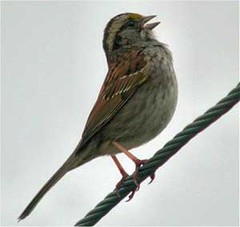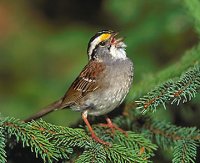Ordinary Beauty
I have been restoring order to my messy apartment and cat sitting most of today and will be doing so for the entire weekend. This means that I don't have as much time as usual to respond to emails, to write blog essays and to finish those articles that are languishing on my computer. I am also writing another scientific paper and preparing for this Friday's interview with "that very respectable college", an interview that will last four hours (I am interviewing for a spring semester teaching position). As part of this interview, I will give a 45 minute presentation. Yesterday, my contact at the college informed me that they want me to give a talk about the physiological and genetic underpinnings of behavior.
Hrm. That sounds remarkably similar to my dissertation work. But they don't want me to talk about my dissertation. So I have decided to prepare a talk about the physiology and genetics of aggression and song in the white-throated sparrow (WTSP), Zonotrichia albicollis. These remarkable little birds are closely related to my own dissertation birds, the white-crowned sparrow, Zonotrichia leucophrys, and they have similar behaviors and physiology. But they are remarkable in the ways that they differ from their close relatives. First, WTSP have two easily identifiable color morphs, the "white morph" and the "tan morph", which describes the color of their head stripes. Both sexes of white-morph birds have higher testosterone levels, higher aggression levels and higher songs rates than do both sexes of tan-morph birds. Basically, WTSPs are color-coded as to their physiological and behavioral traits.
But wait, there's more; these traits are genetic, although the genetics are somewhat more complex than one might initially assume. We know that WTSPs mate assortatively; most breeding pairs of these birds are comprised of one tan morph and one white morph bird and their nests contain chicks of both color morphs. So the chicks are all growing up in a similar environment, and yet their behavior is determined mainly by their genetics. There also is a seasonal component; apparently white morph birds are more aggressive in spring when days are growing longer, whereas they switch roles in winter when tan morphs are typically more dominant.
So I am describing a common migratory wild animal who lives and breeds in our backyards throughout the eastern USA and Canada. This common species has clearly marked morphological differences (tan versus white morphs), each morphology is associated with distinct behavioral traits (differing levels of aggression and song), and these behaviors are supported by a different physiological character (easily measured disparities in plasma testosterone concentrations).
WTSPs are such a strikingly beautiful system that link genetics, physiology, morphology and behavior that simply thinking about them gives me chills of excitement. I hope my presentation captures the beauty of these birds and inspires my audience to think more about them and about what we can learn from them, too. Perhaps my audience will never look at another white-throated sparrow the same way again.
  | |
| Tan morph male white-throated sparrow (left) has subdued tan and brown coloring on its head and face. Photo courtesy of Surfbirds. White morph male white-throated sparrow (right) has a more crisp black and white coloring on its head and face. Photo courtesy of Lang Elliott, linked from Annenberg/CPB Learner.org. |
© 2004, 2005, 2006 by GrrlScientist











3 Peer Reviews:
I'll never look at another white-throated sparrow the same way again. But, Hedwig, I've never looked at any bird the same way since I started reading you.
We just saw a Western Tanager in our pond. We thought it was a American Goldfinch with a red head. Guess what? A bird that looks like Goldfinch with a red head is a Western Tanager, and we know that because we have been encouraged and enlightened by such a fine and astoundingly knowledgeable lover of birds.
We wish you the very best on Friday.
Is this the same sparrow that was introduced from England and is 'sort-of' a pest in the United States? If so, at least now I have a little more respect for it.
Oh, RD, I so miss seeing Western tanagers! I hope you appreciate seeing them for me, too! If it was legal to keep and breed these birds in captivity, I would be the first person in line to do so! (There just aren't enough of these birds in the world, in my opinion).
WTSPs are rare vagrants on the west coast, but you will sometimes find one hanging out with migrating flocks of white-crowned and golden-crowned sparrows.
Hi Tabor. The WTSPs are native birds. The tan morphs look somewhat similar to female English sparrows (they are an imported pest species that most people refer to as "house sparrows". I steadfastly refuse to refer to them by that name because I want people to remember where they originated). House sparrows are not true sparrows; they are weaver birds, whereas WTSPs and others here in North America are true sparrows. Our sparrows are incredibly talented singers; English sparrows possess only a one note song.
GrrlScientist
Post a Comment
<< Home